File Info
| Exam | Nokia NSP IP Network Automation Professional Composite Exam |
| Number | 4A0-AI1 |
| File Name | Nokia.4A0-AI1.VCEplus.2025-02-03.59q.vcex |
| Size | 656 KB |
| Posted | Feb 03, 2025 |
| Download | Nokia.4A0-AI1.VCEplus.2025-02-03.59q.vcex |
How to open VCEX & EXAM Files?
Files with VCEX & EXAM extensions can be opened by ProfExam Simulator.
Coupon: MASTEREXAM
With discount: 20%
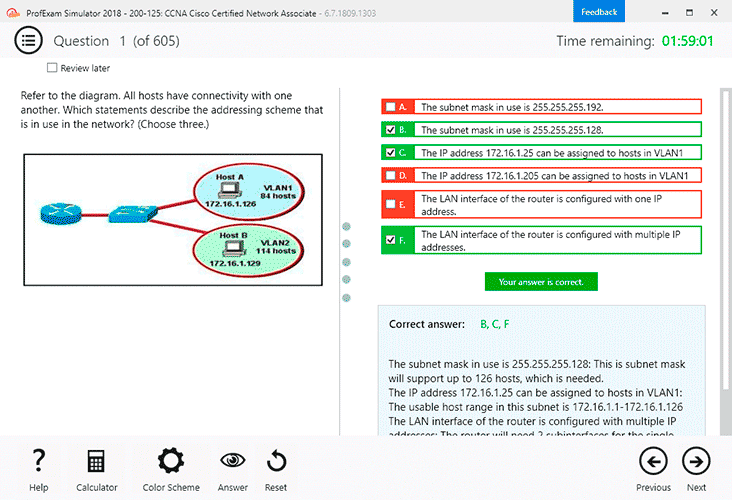
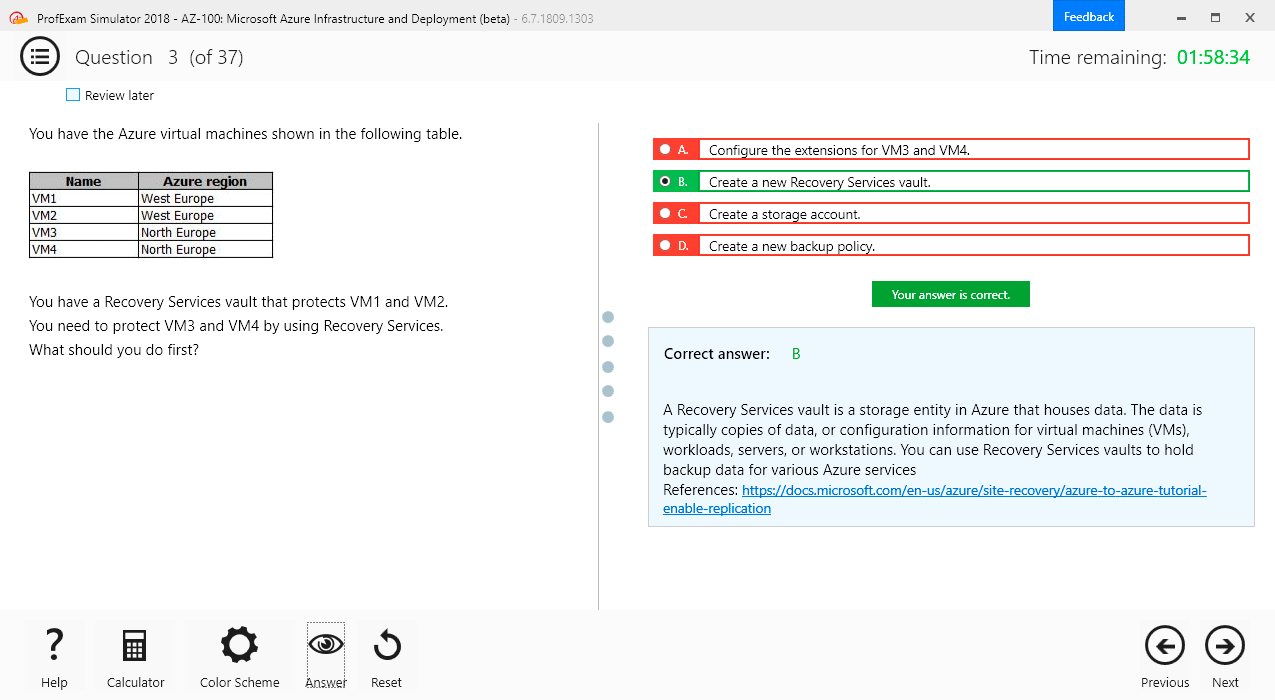
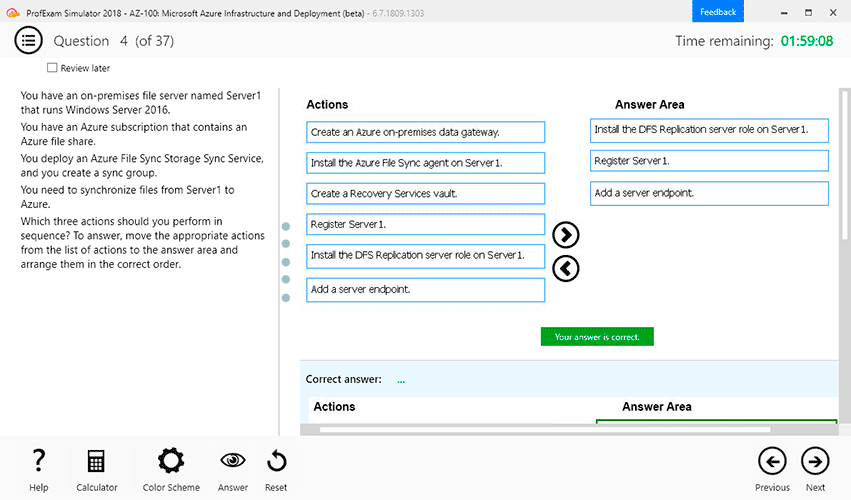
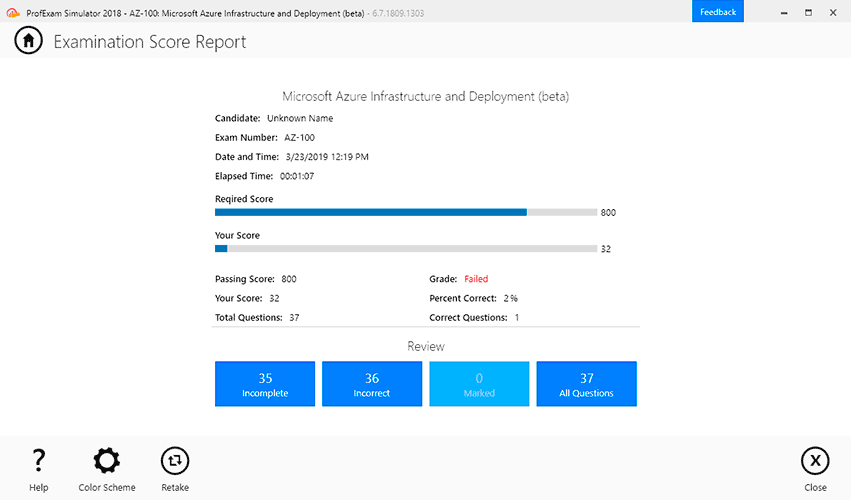
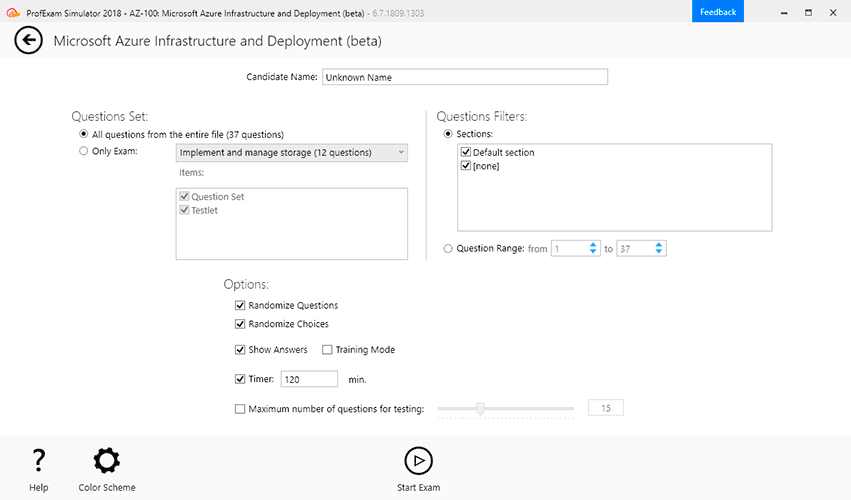

Demo Questions
Question 1
Which of the following is NOT a characteristic of Intent-based networking?
- Abstraction
- Virtualization
- Automation
- Persistence
Correct answer: B
Explanation:
Virtualization is not a characteristic of intent-based networking, but rather a technology that enables it. Virtualization is the process of creating virtual versions of physical resources, such as servers, storage, or networks1.Virtualization allows for more flexibility and scalability in network design and management, but does not imply any automation or intelligence. Virtualization is not a characteristic of intent-based networking, but rather a technology that enables it. Virtualization is the process of creating virtual versions of physical resources, such as servers, storage, or networks1.
Virtualization allows for more flexibility and scalability in network design and management, but does not imply any automation or intelligence.
Question 2
Which of the following statements best describes the Intent Manager application?
- It discovers and manages network elements so they can be used by other NSP applications.
- It provides the ability to simulate changes in the IP topology.
- It generates and validates the configuration of the network.
- It manages YANG-based telemetry.
Correct answer: C
Explanation:
The statement that best describes the Intent Manager application is: "It generates and validates the configuration of the network." Intent Manager is responsible for collecting the user's intent, verifying the user's input, and converting the user's intent into a device-specific configuration. It uses a highlevel language to abstract the network complexity, enabling the network operator to define intent in simple terms. Once the intent is defined, Intent Manager automatically generates a device-specific configuration for each network element. It then validates the intent by checking the network's current state against the user's desired intent. If there is a mismatch, it will take corrective action to bring the network to the desired intent state. The statement that best describes the Intent Manager application is: "It generates and validates the configuration of the network." Intent Manager is responsible for collecting the user's intent, verifying the user's input, and converting the user's intent into a device-specific configuration. It uses a highlevel language to abstract the network complexity, enabling the network operator to define intent in simple terms. Once the intent is defined, Intent Manager automatically generates a device-specific configuration for each network element. It then validates the intent by checking the network's current state against the user's desired intent. If there is a mismatch, it will take corrective action to bring the network to the desired intent state.
Question 3
Which of the following is NOT a characteristic of Infrastructurelure Intents?
- Policy management
- System security
- Initial hardware configuration
- L2/L3 VPN configuration of multiple services
Correct answer: D
Explanation:
Infrastructure Lure Intents are a type of Network Intent that describe how network resources should be allocated and configured for a specific service or application.L2/L3 VPN configuration of multiple services is NOT a characteristic of Infrastructure Lure Intents, because it is more related to service provisioning than resource allocation. Infrastructure Lure Intents are a type of Network Intent that describe how network resources should be allocated and configured for a specific service or application.
L2/L3 VPN configuration of multiple services is NOT a characteristic of Infrastructure Lure Intents, because it is more related to service provisioning than resource allocation.
Question 4
Which of the following allows the Intent Manger to communicate with network elements being managed by SNMP?
- NSP mediator
- MDC mediator
- NFM-P mediator
- Generic mediator
Correct answer: D
Explanation:
Intent Manager to communicate with network elements that are not directly supported by NSP12. A generic mediator can use SNMP or other protocols to interact with network elements. Intent Manager to communicate with network elements that are not directly supported by NSP12. A generic mediator can use SNMP or other protocols to interact with network elements.
Question 5
Which of the following can only be viewed by making a RESTCONF call to query an existing intent?
- abstract YANG model
- ibn:intent model
- template-mappings
- metadata
Correct answer: C
Explanation:
The template-mappings can only be viewed by making a RESTCONF call to query an existing intent.The template-mappings are a set of key-value pairs that map the abstract YANG model attributes to concrete NFM-P templates and parameters. They are not exposed in the UI or the ibn:intent model, but they are stored internally in the NSP database.For example, a template-mapping could be: /network=IP/service=VPN -> nsp-ip-vpn-template. The template-mappings can only be viewed by making a RESTCONF call to query an existing intent.
The template-mappings are a set of key-value pairs that map the abstract YANG model attributes to concrete NFM-P templates and parameters. They are not exposed in the UI or the ibn:intent model, but they are stored internally in the NSP database.
For example, a template-mapping could be: /network=IP/service=VPN -> nsp-ip-vpn-template.
Question 6
Which of the following statements about Nokia's Network Services Platform (NSP) Model-driven Mediation (MDM) framework is FALSE?
- It is based on the YANG data model.
- It uses the NETCONF protocol.
- It provides an abstracted view of the network element.
- It is vendor agnostic.
Correct answer: D
Explanation:
The Nokia NSP Model-driven Mediation (MDM) framework is based on the YANG data model, uses the NETCONF protocol, and provides an abstracted view of the network element. However, it is designed to be vendor-specific, meaning it is designed to only manage Nokia equipment.It provides an abstracted view of the network element is FALSE regarding Nokia's Network Services Platform (NSP) Model-driven Mediation (MDM) framework. MDM provides a way to interface between the Nokia NSP and network elements from different vendors. It is based on the YANG data model and uses the NETCONF protocol to provide configuration and management capabilities for network devices. However, MDM does not provide an abstracted view of the network element.Instead, it translates the native configuration of the network element into a standardized YANG model, allowing the NSP to manage the network element in a vendor-agnostic way.According to the NSP NSD and NRC 18.6 Planning Guide1, Model-Driven Mediation (MDM) is a component within the NSP architecture that provides mediation between model-driven NSP applications and Nokia or third-party network devices. MDM provides an adaptation layer which uses adaptors to convert NSP application requests to device specific directives using standard protocols such as NETCONF, SNMP and CLI over SSH or Telnet12.MDM also provides an abstracted view of the network element3. The Nokia NSP Model-driven Mediation (MDM) framework is based on the YANG data model, uses the NETCONF protocol, and provides an abstracted view of the network element. However, it is designed to be vendor-specific, meaning it is designed to only manage Nokia equipment.
It provides an abstracted view of the network element is FALSE regarding Nokia's Network Services Platform (NSP) Model-driven Mediation (MDM) framework. MDM provides a way to interface between the Nokia NSP and network elements from different vendors. It is based on the YANG data model and uses the NETCONF protocol to provide configuration and management capabilities for network devices. However, MDM does not provide an abstracted view of the network element.
Instead, it translates the native configuration of the network element into a standardized YANG model, allowing the NSP to manage the network element in a vendor-agnostic way.
According to the NSP NSD and NRC 18.6 Planning Guide1, Model-Driven Mediation (MDM) is a component within the NSP architecture that provides mediation between model-driven NSP applications and Nokia or third-party network devices. MDM provides an adaptation layer which uses adaptors to convert NSP application requests to device specific directives using standard protocols such as NETCONF, SNMP and CLI over SSH or Telnet12.
MDM also provides an abstracted view of the network element3.
Question 7
Which of the following protocols or standards is NOT used in Model Driven Telemetry?
- CLI
- NETCONF
- gRPC
- KAFKA
Correct answer: A
Explanation:
CLI is not used in Model Driven Telemetry. Model Driven Telemetry is a technology that uses YANG data models, NETCONF, gRPC and KAFKA to monitor and collect data from network elements. It provides an abstracted view of the network element and is vendor agnostic.Model Driven Telemetry is a method of collecting real-time data from network devices, allowing for more efficient network monitoring and troubleshooting. It uses a variety of protocols and standards, including NETCONF, gRPC, and Kafka. However, CLI is a text-based user interface used for issuing commands to a device, and it is not typically used for collecting telemetry data.According to the Nokia Network Services Platform for industry and the public sector datasheet1, NSP model-driven telemetry framework supports the Nokia SR OS and third-party devices in configuring and collecting performance statistics using gRPC, SNMP, NETCONF and accounting files such as SAP QoS1. It also enables data to be persisted in a database and be made available (e.g., over a Kafka bus) for a variety of use cases1. CLI is not used in Model Driven Telemetry. Model Driven Telemetry is a technology that uses YANG data models, NETCONF, gRPC and KAFKA to monitor and collect data from network elements. It provides an abstracted view of the network element and is vendor agnostic.
Model Driven Telemetry is a method of collecting real-time data from network devices, allowing for more efficient network monitoring and troubleshooting. It uses a variety of protocols and standards, including NETCONF, gRPC, and Kafka. However, CLI is a text-based user interface used for issuing commands to a device, and it is not typically used for collecting telemetry data.
According to the Nokia Network Services Platform for industry and the public sector datasheet1, NSP model-driven telemetry framework supports the Nokia SR OS and third-party devices in configuring and collecting performance statistics using gRPC, SNMP, NETCONF and accounting files such as SAP QoS1. It also enables data to be persisted in a database and be made available (e.g., over a Kafka bus) for a variety of use cases1.
Question 8
Which of the following statements about the NSP Workflow Manager (WFM) application is FALSE?
- It allows network management tasks to be automated.
- Only one workflow can be executed at one time.
- Actions and expressions are extensible using Python.
- A workflow action can run against RESTCONF APIs.
Correct answer: B
Explanation:
The NSP Workflow Manager (WFM) application allows network management tasks to be automated by creating workflows. Multiple workflows can be run in parallel, and actions and expressions are extensible using Python.Additionally, a workflow action can run against RESTCONF APIs.According to the NSP Release 19.11 Workflow Manager Application Help1, Workflow Manager (WFM) is an application that allows network management tasks to be automated using Nokia NSP or third-party APIs1. WFM supports a variety of use cases such as node software upgrades, service activation tests, service fulfillment and mass migration of services12. WFM uses actions and expressions that are extensible using Python1. A workflow action can run against RESTCONF APIs as well as other protocols such as SNMP, NETCONF and CLI1. The NSP Workflow Manager (WFM) application allows network management tasks to be automated by creating workflows. Multiple workflows can be run in parallel, and actions and expressions are extensible using Python.
Additionally, a workflow action can run against RESTCONF APIs.
According to the NSP Release 19.11 Workflow Manager Application Help1, Workflow Manager (WFM) is an application that allows network management tasks to be automated using Nokia NSP or third-party APIs1. WFM supports a variety of use cases such as node software upgrades, service activation tests, service fulfillment and mass migration of services12. WFM uses actions and expressions that are extensible using Python1. A workflow action can run against RESTCONF APIs as well as other protocols such as SNMP, NETCONF and CLI1.
Question 9
Match the following description with its meaning.
X - "uses Playbooks, written in simple YAML, that defines server configuration."
Y - "workflow service that aims to provide a way to define, manage, and execute tasks and workflows in the cloud without writing code."
Z - "a detailed specification for the desired network configuration."
W - "an application that allows the creation of complex operational workflows using an intuitive GUI."
- X - Openstack MistralY - AnsibleZ - Intent typeW - NSP Workflow Manager (WFM)
- X - AnsibleY - Openstack MistralZ - NSP Workflow Manager (WFM)W - Intent type
- X - AnsibieY - Openstack MistralZ - Intent typeW - NSP Workflow Manager (WFM)
- X - NSP Workflow Manager (WFM)Y - Openstack MistralZ - Intent typeW - Ansible
Correct answer: D
Question 10
Which of the following is NOT part of the Augmented Assurance features provided by the NSP?
- Sorting NEs by highest severity issues
- Intelligent visualization
- Commissioning of equipment
- On-demand OAM testing
Correct answer: C
Explanation:
Augmented Assurance is a feature that provides "extended automated network operations" with "open APIs and no-code customizable workflows". Another source2 mentions that NSP offers "automated repetitive tasks and complex workflows" to reduce operating costs.The Augmented Assurance features provided by the NSP (Nokia Network Services Platform) include:Sorting NEs by highest severity issues B. Intelligent visualization D. On-demand OAM testing Augmented Assurance is a feature that provides "extended automated network operations" with "open APIs and no-code customizable workflows". Another source2 mentions that NSP offers "automated repetitive tasks and complex workflows" to reduce operating costs.
The Augmented Assurance features provided by the NSP (Nokia Network Services Platform) include:
Sorting NEs by highest severity issues B. Intelligent visualization D. On-demand OAM testing

